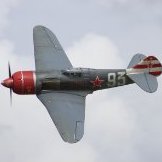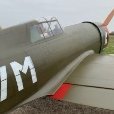-
Posts
8,613 -
Joined
-
Last visited
-
Days Won
35
Jon H last won the day on April 5 2023
Jon H had the most liked content!
Recent Profile Visitors
The recent visitors block is disabled and is not being shown to other users.
Jon H's Achievements
1.7k
Reputation
-
On the climbing/diving thing i do not agree that it is related to c/g, at least within the realms i am on about. Its virtually impossible to get a scale model to be in trim through its entire speed range and certainly the full size is trimmed regularly. Even your basic cessna is constantly in need of trimming so if a model climbs with speed and falls with less speed i would consider this normal. My sea fury is the most neutral of my warbird fleet and its also the one with the thinnest and most symmetrical wing. My La7 and P39 really need a good shove of forward elevator at high speed. In the case of the P39 i have watched a number of those old WWII training videos for the full size and from many of the shots i can see my model behaving very much like the full size. In practice its not an issue and i just hold the nose down with some forward stick on fast passes. However, if a model climbs with power, that is another story and engine thrust lines should be investigated. Again i keep things simple these days with 0-0 on my up/side thrust and just fly the thing. I have not come across a warbird yet were this has been any kind of problem. The only tricky part is working out if the model is climbing with speed or power, but usually this can be tested by just opening and closing the throttle before the speed has a chance to change much. When it comes to rates, i have high/low set for ailerons and elevator on different switches. Generally i use high elevator low aileron for takeoff, and go to low elevator when in the air with the gear up. Landing is normally the same but i may use high aileron rate if the wind is choppy and i want more authority. Lowering flaps also enables my elevator flap mix to effectively trim the model for the landing configuration as the slow speed and drag of te gear usually makes the model want to bury its nose in the earth.
-
From your description it sounds like there should be more than enough compression to me. I was once distracted by a phone call and forgot to put piston rings in a laser i assembled. On test It started and ran, even tuned up, but idle and acceleration was very poor and compression very low so i took it apart to find out why. Imagine my surprise to find no rings! While i appreciate that glow and diesel are not the same, the basic point is these engines should operate to some degree even when the fit is less than stellar. Also, if you can get the thing running the heat cycles should grow the piston slightly and you may find it all comes good. The trick is getting the thing going in the first place. I echo the feeling of others who are cautious about an electric starter, but used correctly it might be the way to go as the dynamic compression will be higher than when hand flipped. If you use an electric starter do not prime the engine at all and just let it draw its own fuel. I am sure there will be a way to get it going.
-
There has been plenty of comment on the compression, the piston nip etc but its very hard to quantify. Are you able to post a video showing the engine being flipped over with a prop on? Might be able to judge better what it happening. Unless the fit is truly awful, which i doubt, a heavy port prime and gradual increase of compression while flicking should at least get a pop out of it even if it wont run right away. I find it strange that it is completely devoid of life.
-
Yea, and the 20% castor recommendation was binned in favour of 15% synth by the mid 90's, then halved to 7% a few years back. While i dont think 7% synth is a good idea in this case, 15 will be absolutely no problem.
-
a gusting wind can wipe out any model under the right (or wrong?) circumstances. My little hurricane got faceplanted into the runway once with a sharp downdraft despite full corrective action. But as you say, these traditional models can usually absorb the abuse and bent undercarriage was the worst of it. One other thing to consider though is the model is now a half pound lighter and will fly that bit slower. If your flare was at the normal speed you are used to you may have had just enough excess energy for the wind to really pick it up before dropping it back down. That said, it would probably have been a non event had the engine not decided to give up at that exact moment. In any case, retracts are always more prone to damage and I tend to hangar my warbirds in gusting conditions for that reason. Last weekend i took my sea fury to put some hours on the rebuilt engine. The first 3 flights were perfect with nice smooth landings. The 4th took me 3 approaches with 2 go arounds as i couldnt get it stable as the wind had swung to the north a little and the turbulence off some trees caused real problems. WIth the wind in that direction, 4 flights already and an undamaged model i decided to call it a day.
-
I have OS engines of the same vintage running 15% synthetic and 5 nitro with no issues and i cant see any reason why there ever would be. 25% oil will make an utterly horrendous mess and there is just no need for it.
-
ill add my 2p as well. I can see that if you had 2 identical models, but one was a brick, it might be less stable than its lighter mate when flown at the same speed as it would need a greater aoa, but generally weight is not a factor as long as the model is within the range of weights appropriate for its size. On reynolds and all that...ehhh its pretty much meaningless unless we are building exact scale replicas with identical wing sections etc. As we dont tend to do that, just forget it and move on. As a side note, most model warbirds tend to have over size tails to 'improve stability'. I have a big problem with this as making the tail bigger also makes the elevator bigger, and thus more effective. This makes an already sensitive model more sensitive leading to excess nose weight to tame the beast. I believe this larger tail idea is a hangover from the free flight days when the bigger tail would have probably been an asset. However, now we have our dumb thumbs on the controls the static stability of the aircraft is less important as we are able to correct deviations we do not like. With this in mind i built my little hurricane with a scale (or more scale) tail on it and i have no stability problems with it, and my elevator movements are still very small. So take that modelling folk lore. I advocate scale tails and rearward c/g in the pursuit of model warbird bliss. Oh and i cant be bothered with side or down thrust either. Mount it straight and use the tall waggly thing on the back.
-
yep it will be fine Tank in the right place, OS f plug, correct prop for model (what is it?) With that sorted, start it, tune it, fly it. Repeat until tired, go home, crack open a beer (or beverage of your choice) and reflect on your day of flying. Hopefully the engine is in decent mechanical condition. I would recommend you whip the front housing off the engine and take peek inside before you run it. If its rusty or otherwise not nice change the bearings etc and then go from there.
-

Laser engine, how do you tell what size they are?
Jon H replied to martin collins 1's topic in All Things Model Flying
Ah look see, i try and help one chap id his engine and im back doing a job i no longer have for a company that no longer exists at half 7 on a Monday night. I dont mind helping out here and there but going through the entire range from start to finish would be like writing war and peace. Just the 150 alone has about 6 major versions to cover although many of the versions hardly differ visually. I have given details for the 100 and 120, the 150 is the same as the 120 just 100mm tall not 90. That's going to have to do for now. -

Laser engine, how do you tell what size they are?
Jon H replied to martin collins 1's topic in All Things Model Flying
Martin yours is a 100, Brian's a 120 circa...ehh 96? sure why not. 120 has 45mm case, 90mm tall, bulges for head bolts on crankcase above mount rails, large head, large exhaust etc...and, it just looks like a 120 as that is what 120's look like. -

Laser engine, how do you tell what size they are?
Jon H replied to martin collins 1's topic in All Things Model Flying
Well it looks like a 100...they look like that. if it looks like that its a 100 as that is what they look like. This is also a 100. 100's look like this https://www.laserengines.com/product/laser-100/ You will note it looks the same as the old one, just not as square. What else...well 45mm case, 100mm tall...square case with no bulges above the mount rails for head bolts....small head, small carb, small exhaust....and it just looks like a 100. -

Laser engines - the state of play following their closure
Jon H replied to Ron Gray's topic in IC Engines
it couldnt have been done for the same price as a common throw crank. A full boxer would have cost a fortune and at maybe twice the cost of a v it wouldnt have sold. Also as vibration with a single throw was not a problem on test, and no owner has ever complained its a moot point anyway. This was discussed to death during the development. I have seen posts on facebook from people who have not owned one or seen one run claiming excessive vibration, but they simply havent a clue what they are talking about. They run fine, not as smooth as a V but not as 'bad' as a single, and power that thrashes the competition. Although unrelated, i like the 180 degree firing interval too. Makes a nice sound. -

Laser engine, how do you tell what size they are?
Jon H replied to martin collins 1's topic in All Things Model Flying
Dont look at me. i stamped the size on mine and in 1993 i was only 8 so not my problem. -

Laser engine, how do you tell what size they are?
Jon H replied to martin collins 1's topic in All Things Model Flying
Its a 100. 1993 manufacture. There is an outside chance its a very late 90, but i doubt it. Weights are meaningless as carbs changed, early engines had solid cranks, later ones hollow etc.



.thumb.jpg.507e8e41f64a8a0ae8fbd699d456cbca.jpg)

